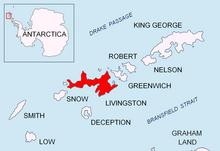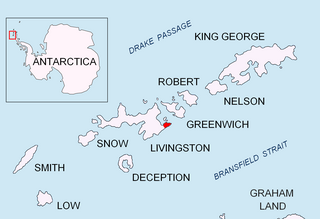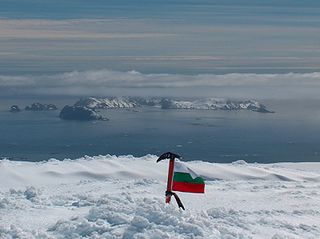


Bruix Cove is the 1.93 km wide cove indenting for 1.75 km the south coast of Moon Bay in eastern Livingston Island, the South Shetland Islands in Antarctica. Entered between Yana Point and Rila Point. Most of the cove's coastline is formed by the terminus of Iskar Glacier.

Moon Bay is a bay 7 nautical miles (13 km) wide which recedes 4 nautical miles (7 km) between Edinburgh Hill and Renier Point, on the east side of Livingston Island, in the South Shetland Islands off Antarctica. The glaciers Sopot Ice Piedmont, Iskar, Huron, Struma, Kaliakra, Panega and Debelt feed the bay.

Livingston Island is an Antarctic island in the South Shetland Islands, Western Antarctica lying between the islands of Greenwich and Snow. This island was the first land discovered south of 60° south latitude in 1819, and the name Livingston, although of unknown derivation, has been well established in international usage since the early 1820s.

The South Shetland Islands are a group of Antarctic islands with a total area of 3,687 square kilometres (1,424 sq mi). They lie about 120 kilometres (75 mi) north of the Antarctic Peninsula, and between 430 kilometres (270 mi) to 900 kilometres (560 mi) south-west from the nearest point of the South Orkney Islands. By the Antarctic Treaty of 1959, the islands' sovereignty is neither recognized nor disputed by the signatories and they are free for use by any signatory for non-military purposes.
Contents
The feature is named after Baron Alexis-Vital-Joseph (Spanish : Alejo) de Bruix (c. 1790-1825), a French military who took part in the Napoleonic Wars and the Spanish American wars of independence.

Spanish or Castilian is a Western Romance language that originated in the Castile region of Spain and today has hundreds of millions of native speakers in the Americas and Spain. It is a global language and the world's second-most spoken native language, after Mandarin Chinese.

France, officially the French Republic, is a country whose territory consists of metropolitan France in Western Europe and several overseas regions and territories. The metropolitan area of France extends from the Mediterranean Sea to the English Channel and the North Sea, and from the Rhine to the Atlantic Ocean. It is bordered by Belgium, Luxembourg and Germany to the northeast, Switzerland and Italy to the east, and Andorra and Spain to the south. The overseas territories include French Guiana in South America and several islands in the Atlantic, Pacific and Indian oceans. The country's 18 integral regions span a combined area of 643,801 square kilometres (248,573 sq mi) and a total population of 67.3 million. France, a sovereign state, is a unitary semi-presidential republic with its capital in Paris, the country's largest city and main cultural and commercial centre. Other major urban areas include Lyon, Marseille, Toulouse, Bordeaux, Lille and Nice.

The Napoleonic Wars (1803–1815) were a series of major conflicts pitting the French Empire and its allies, led by Napoleon I, against a fluctuating array of European powers formed into various coalitions, financed and usually led by the United Kingdom. The wars stemmed from the unresolved disputes associated with the French Revolution and its resultant conflict. The wars are often categorised into five conflicts, each termed after the coalition that fought Napoleon: the Third Coalition (1805), the Fourth (1806–07), the Fifth (1809), the Sixth (1813), and the Seventh (1815).








